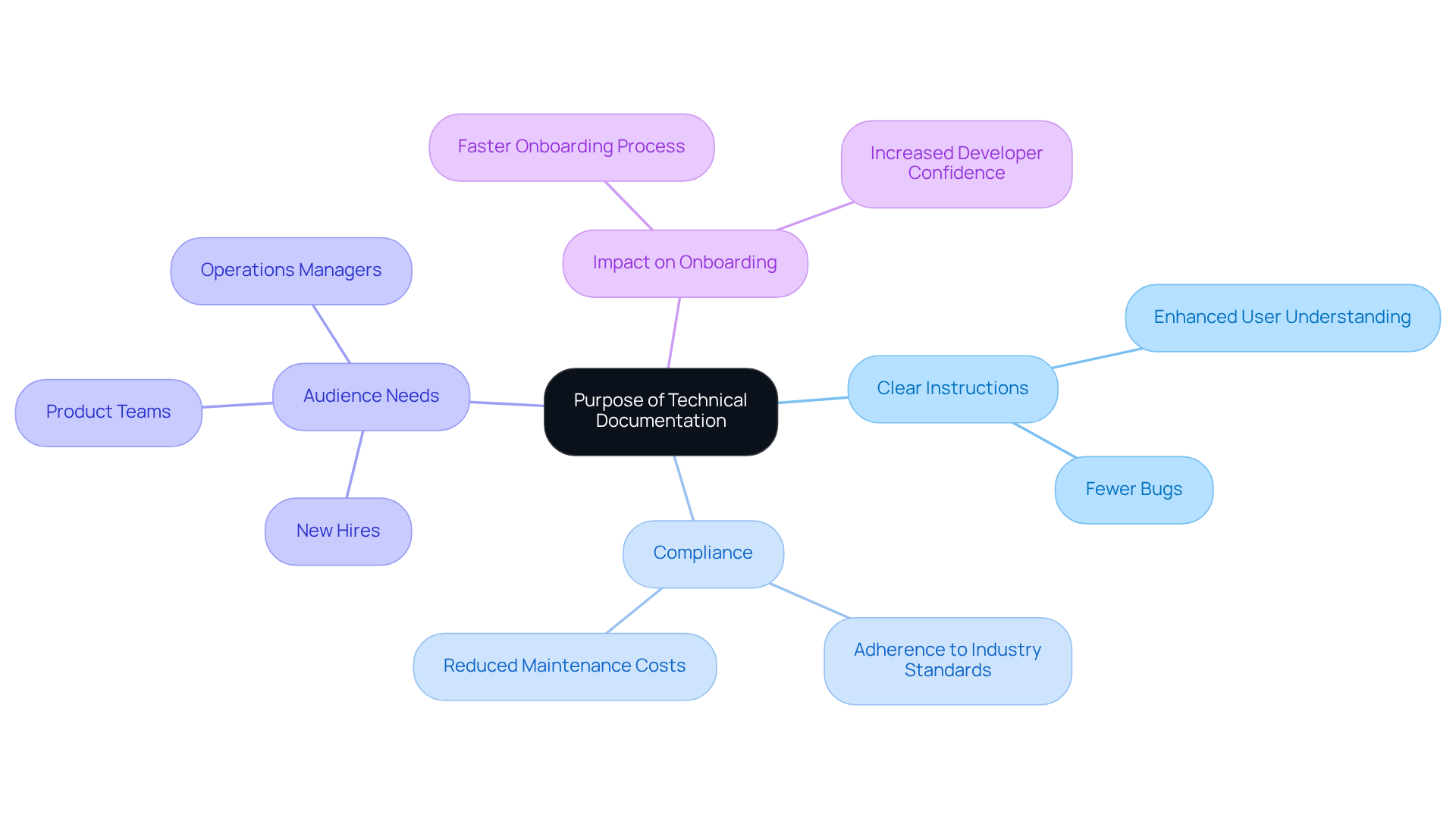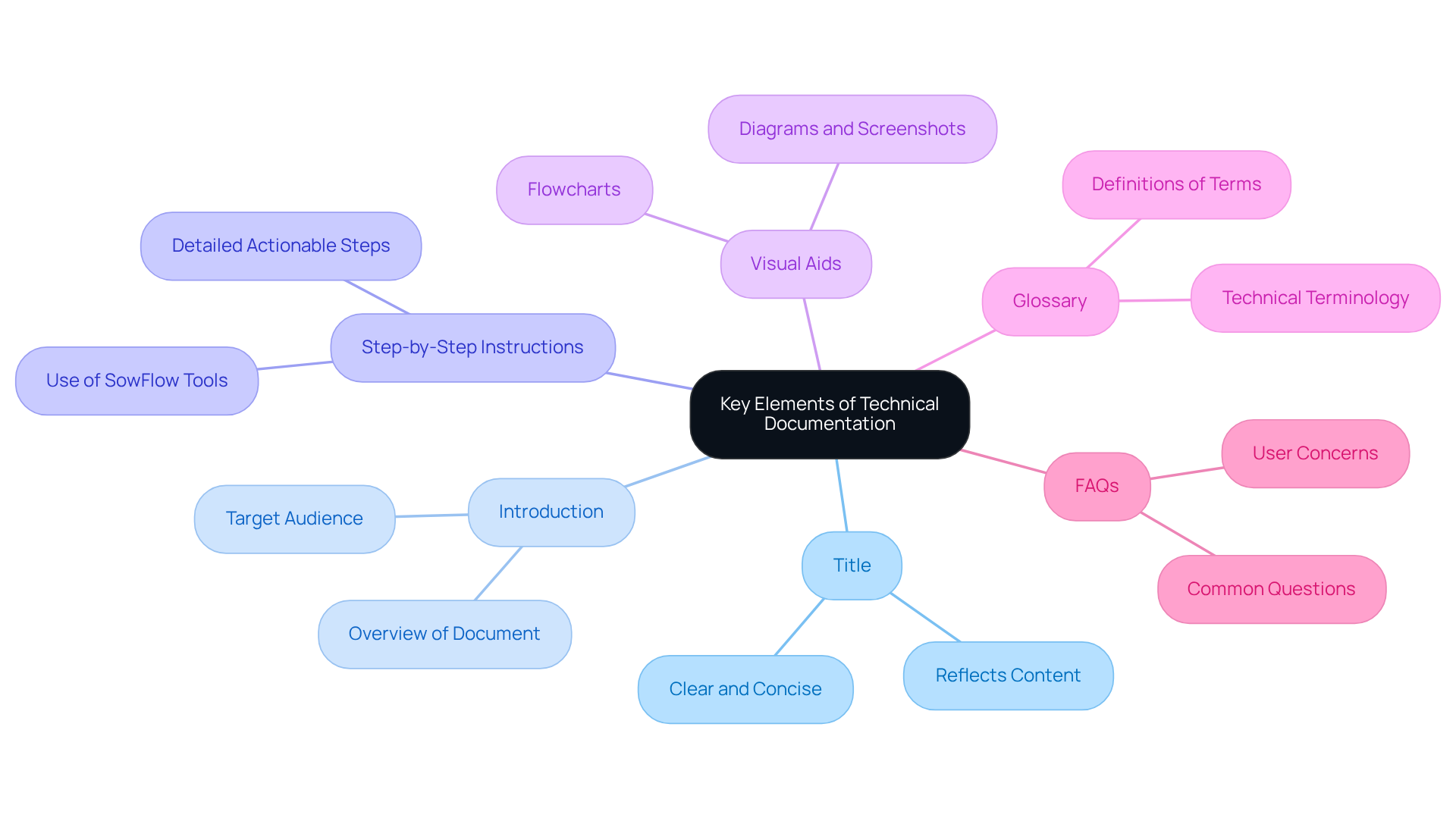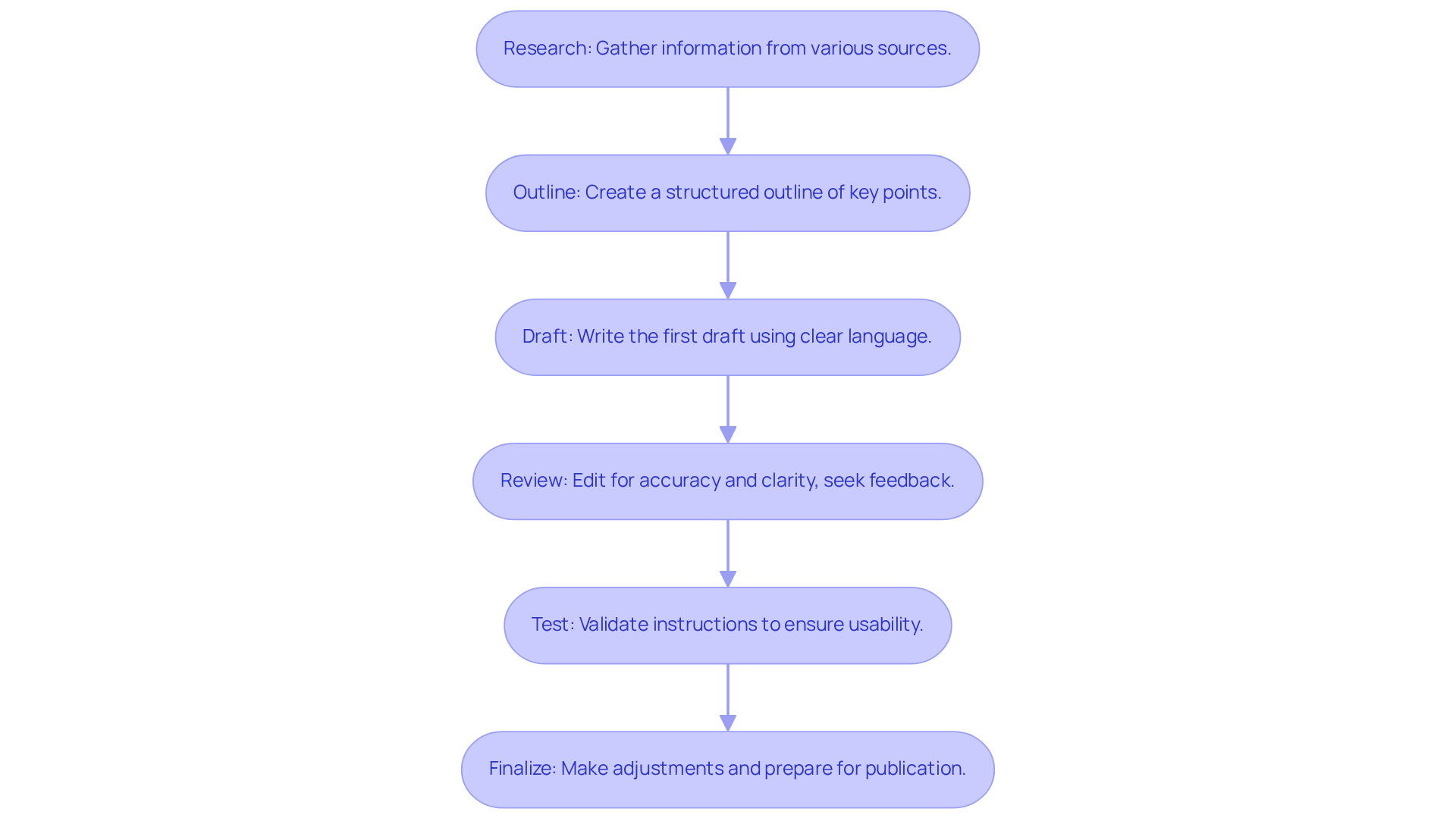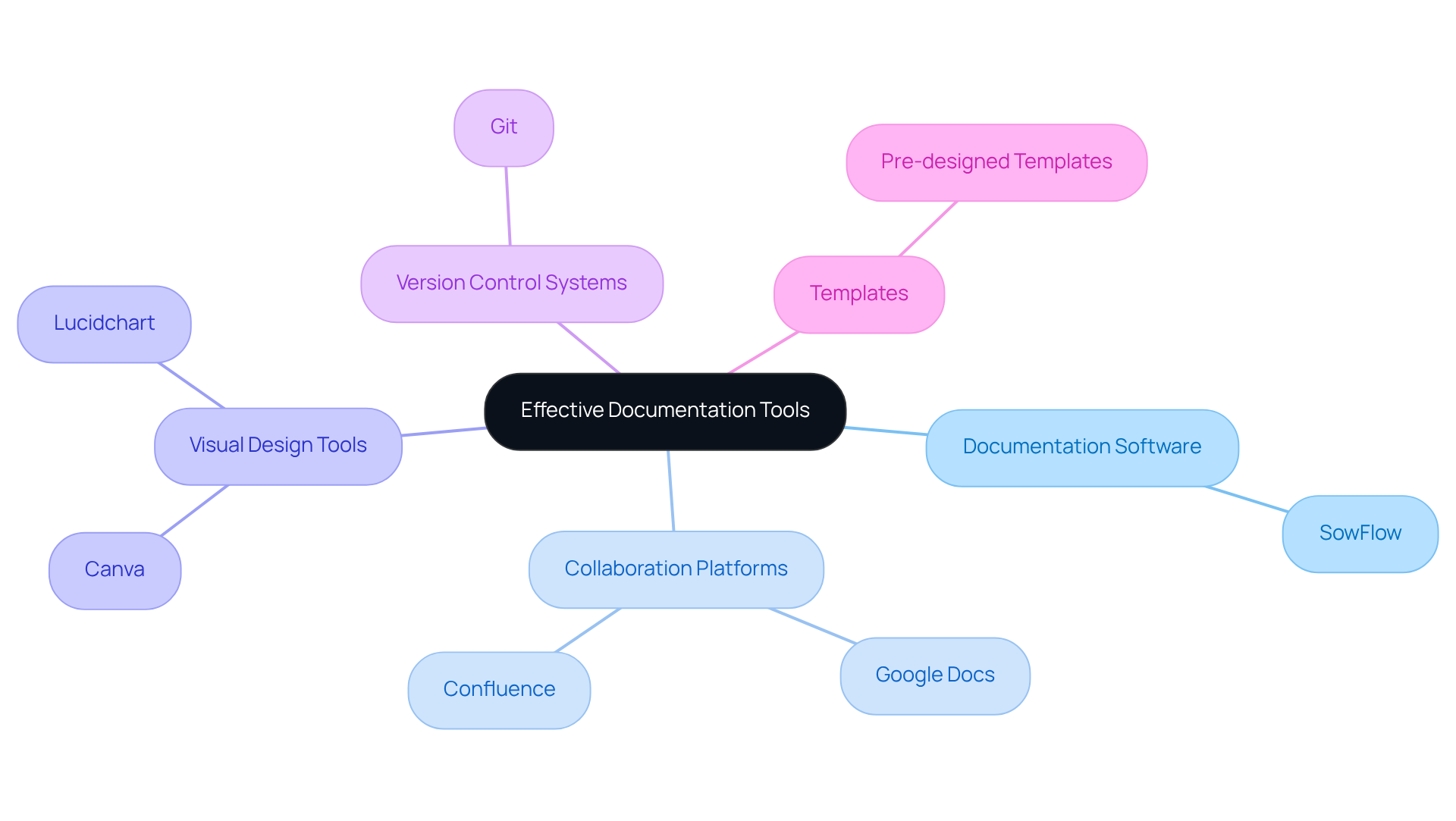
Overview
You might be wondering what it takes to write successful technical documentation. Well, it all starts with establishing a clear purpose. From there, you’ll want to incorporate essential elements like step-by-step instructions and visual aids. Following a structured writing process—from research to finalization—is key.
Speaking of clarity, it’s not just about putting words on a page. Clear and organized documentation not only boosts user understanding and retention but also makes onboarding a breeze and cuts down on errors in technical tasks. This, in turn, drives operational success. So, let’s dive into the benefits of effective documentation and how it can really make a difference in your workflow!
Key Highlights:
- Technical documentation is crucial for delivering clear instructions, ensuring compliance, and preserving institutional knowledge.
- Establishing a clear purpose for documentation enhances user understanding and retention, particularly for diverse audiences.
- Statistics show that efficient technical materials accelerate employee onboarding and improve developers' understanding of code, leading to fewer bugs.
- Key elements of effective documentation include a clear title, introduction, step-by-step instructions, visual aids, glossary, and FAQs.
- A structured writing process involves researching, outlining, drafting, reviewing, testing, and finalising documentation.
- Utilising tools like SowFlow, Google Docs, Canva, and version control systems enhances the documentation process and ensures quality.
Introduction
You might be wondering how technical documentation fits into the big picture of communication within organizations. Well, it really serves as the backbone! It ensures that complex processes are not just understood but are also easy to access. By mastering the art of writing technical documentation, you can create invaluable resources that help everyone retain knowledge and boost operational efficiency. But here’s the challenge: how do you turn intricate information into user-friendly documents that really resonate with a diverse audience? Let’s dive into that!
Understand the Purpose of Technical Documentation
You might be wondering why technical records are so important. Well, they do a lot of heavy lifting! Not only do they deliver clear instructions that aid in writing technical documentation, but they also help ensure compliance with industry standards and preserve valuable institutional knowledge. Think of them as a vital reference for employees, allowing everyone to understand processes and systems on their own, which means less reliance on colleagues.
When you establish a clear purpose for your materials, you can tailor your writing technical documentation to meet the specific needs of your audience—whether that’s new hires, product teams, or operations managers. This clarity not only enhances the structure and content of your materials but also significantly boosts user understanding and retention.
Now, let’s dive into some numbers! Statistics show that efficient technical materials can really make a difference in employee onboarding. Organizations report that clear resources help new hires get up to speed faster. Plus, did you know that 80% of developers say that having adequate records improves their understanding of code? This leads to fewer bugs and better collaboration. By prioritizing clarity in your records and writing technical documentation, you’re fostering a culture of compliance and knowledge retention, which ultimately drives operational efficiency and success.

Identify Key Elements to Include in Your Documentation
When you're diving into technical documentation, you might be wondering what key elements to include. Here’s a friendly checklist to help you out:
- Title: Make sure it’s clear and concise, reflecting what the content is all about.
- Introduction: Give an overview of what the document covers and who it’s for.
- Step-by-Step Instructions: Provide detailed, actionable steps that guide folks through processes. You can easily craft these using SowFlow's intuitive guide creation tools.
- Visual Aids: Incorporate diagrams, screenshots, or flowcharts to enhance understanding, all of which can be effortlessly added to your materials with SowFlow's features.
- Glossary: Include definitions of technical terms to help everyone stay on the same page.
- FAQs: Address common questions and answers to tackle potential user concerns, ensuring your materials remain relevant and up-to-date with SowFlow's instant update capabilities.
By weaving these elements into your documentation, you create materials that are not only thorough but also accessible, catering to a diverse audience while empowering your team with instant access to essential information.

Follow a Step-by-Step Process for Writing Documentation
Creating effective technical documentation? Let’s break it down into some easy steps:
- Research: First things first, gather all the info you can about your topic. Dive into existing materials, chat with users, and connect with subject matter experts. This way, you’ll really get a solid grasp of what you’re dealing with.
- Outline: Next up, whip up a structured outline that lays out the key points from your research. A well-organized outline can make a world of difference, leading to clearer and more concise writing. In fact, studies show that having structured records can boost the quality score significantly—so don’t skip this step!
- Draft: Time to write your first draft! Focus on being clear and concise. Use simple language and steer clear of jargon to keep it accessible for everyone. Think of this draft as your starting point for revisions. And remember, as Maja Hansen points out, knowing your audience is key to effective writing.
- Review: Now, let’s edit that draft for accuracy and clarity. Getting feedback from peers is super important—different perspectives can highlight gaps you might have missed and elevate the overall quality. Keep collaborating with those subject matter experts to ensure everything stays accurate and relevant.
- Test: If it makes sense, test out the instructions to see if they work as intended. This step is crucial for making sure people can follow your guidelines without scratching their heads in confusion.
- Finalize: Finally, make any necessary tweaks based on the feedback and testing outcomes. Format your document nicely for publication to make it visually appealing and easy to navigate. Don’t forget to proofread and use grammar checkers before you hit publish—this keeps things professional and clear.
By following this organized approach in writing technical documentation, you’ll create materials that are not just informative but also user-friendly, enhancing the experience for everyone involved and helping to cut down on support costs.

Utilize Tools and Resources for Effective Documentation
To enhance your documentation process, have you considered tapping into a variety of tools and resources?
- Documentation Software: SowFlow really shines as a powerful solution for creating, managing, and updating documentation efficiently. Its user-friendly interface allows you to whip up thorough how-to guides in no time, keeping your materials relevant and current.
- Collaboration Platforms: Tools like Google Docs and Confluence are fantastic for real-time teamwork and feedback, which can really amp up the writing process. Did you know that effective teamwork can boost engagement by 60%? That makes these platforms essential for fostering collaboration among your team members.
- Visual Design Tools: Why not utilize tools like Canva or Lucidchart to create diagrams and flowcharts that complement your text? Visual aids can really enhance comprehension and retention of complex information, making your materials even more effective.
- Version Control Systems: Implementing systems like Git can help you track changes and maintain document versions. This way, everyone on your team is working with the most current information, which cuts down on miscommunication and errors.
- Templates: Pre-designed templates can be a real time-saver and ensure consistency across your documents. By standardizing formats, you simplify the paperwork and boost overall quality.
By effectively utilizing these tools, you can streamline your process of writing technical documentation, making it easier to create high-quality, accessible content that meets your organization’s needs. So, what do you think? Ready to give these a try?

Conclusion
You might be wondering why writing effective technical documentation is so important. Well, it’s not just about ticking boxes for compliance or keeping records; it’s about empowering your team. When documentation is clear and accessible, it helps everyone navigate processes on their own, boosting operational efficiency and reducing the need to constantly ask colleagues for help.
So, how do you craft this kind of documentation? The article highlights some essential strategies, like:
- Using clear titles
- Step-by-step instructions
- Visual aids
It’s all about having a structured writing process—from doing thorough research and outlining to drafting and reviewing. This way, the final product is not only informative but user-friendly too! Plus, tools like SowFlow and collaboration platforms can really make a difference, streamlining the whole documentation process and enhancing the quality and accessibility of your materials.
Ultimately, investing in well-crafted technical documentation goes beyond just meeting immediate needs; it’s about creating a culture of knowledge sharing and continuous improvement. So, why not adopt these best practices? By utilizing the resources available, you can create documentation that informs and empowers users. This approach will help enhance understanding, reduce errors, and foster a more collaborative work environment, driving success in your projects and operations. Now, doesn’t that sound like a win-win?
Frequently Asked Questions
What is the purpose of technical documentation?
The purpose of technical documentation is to deliver clear instructions, ensure compliance with industry standards, and preserve valuable institutional knowledge, serving as a vital reference for employees to understand processes and systems independently.
How can establishing a clear purpose for technical materials benefit the writing process?
Establishing a clear purpose allows you to tailor your technical documentation to meet the specific needs of your audience, such as new hires or product teams, enhancing the structure and content, and improving user understanding and retention.
What impact do clear technical materials have on employee onboarding?
Clear technical materials help new hires get up to speed faster, leading to more efficient onboarding processes within organizations.
How do adequate records affect developers' understanding of code?
Statistics show that 80% of developers believe having adequate records improves their understanding of code, which results in fewer bugs and better collaboration.
What overall culture does prioritizing clarity in technical documentation foster?
Prioritizing clarity in technical documentation fosters a culture of compliance and knowledge retention, ultimately driving operational efficiency and success.
👍
What others are liking
5 Steps to outline your ideal documentation structure
5 MINS READ
Where to start the your journey of mapping out your ideal documentation structure, aligning it with the very heartbeat of your organization?
Defining a winning level of detail in your process
3 MINS READ
What is too much detail, and what is too little? This article described in that winning level detail about what detail is enough.





